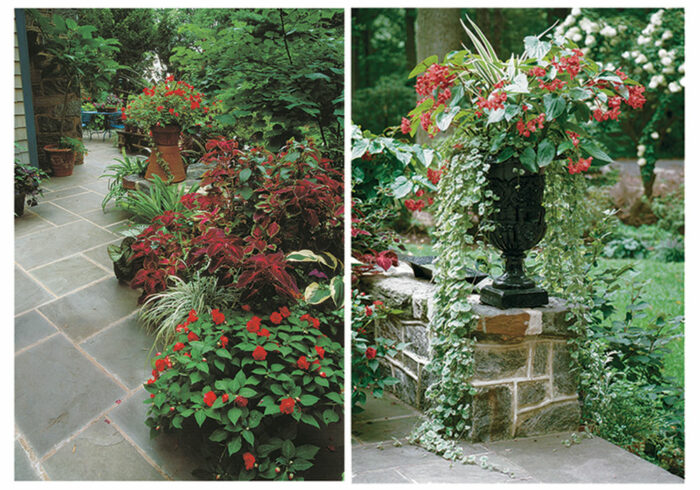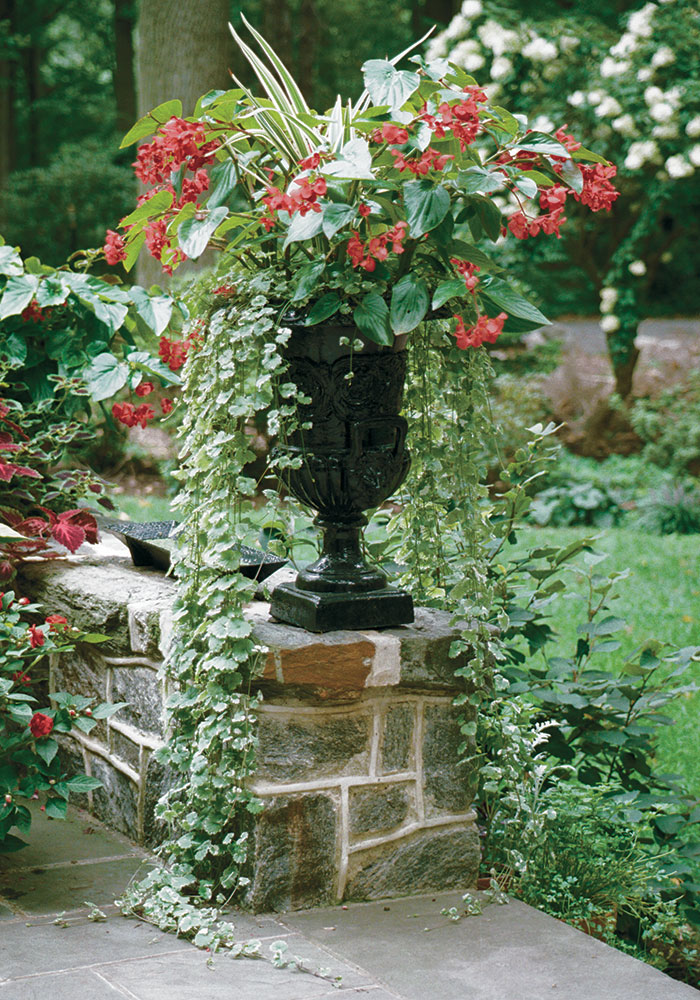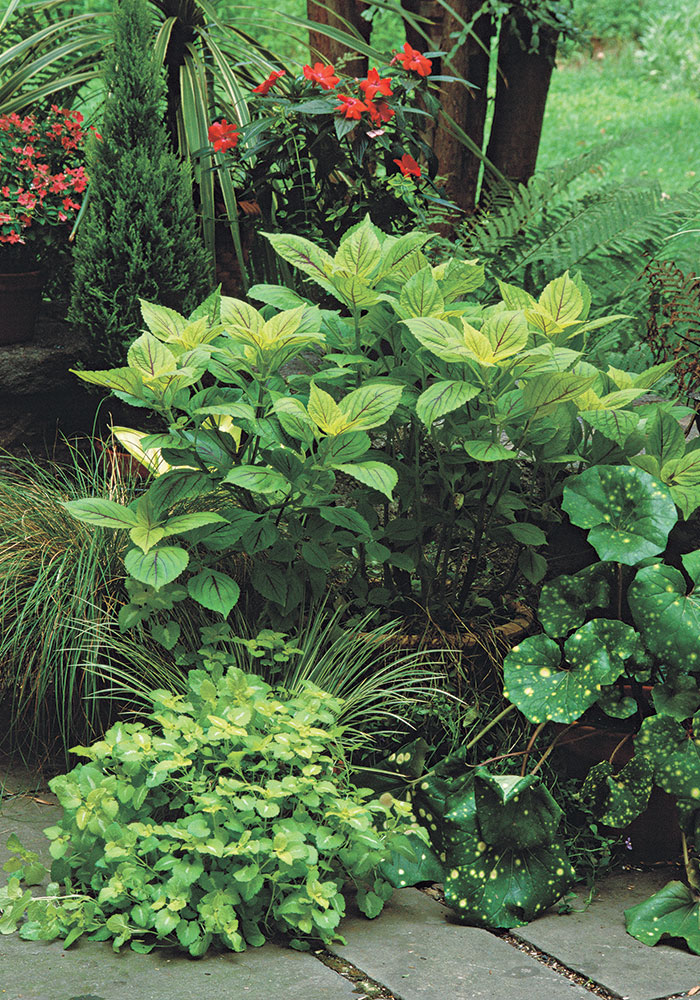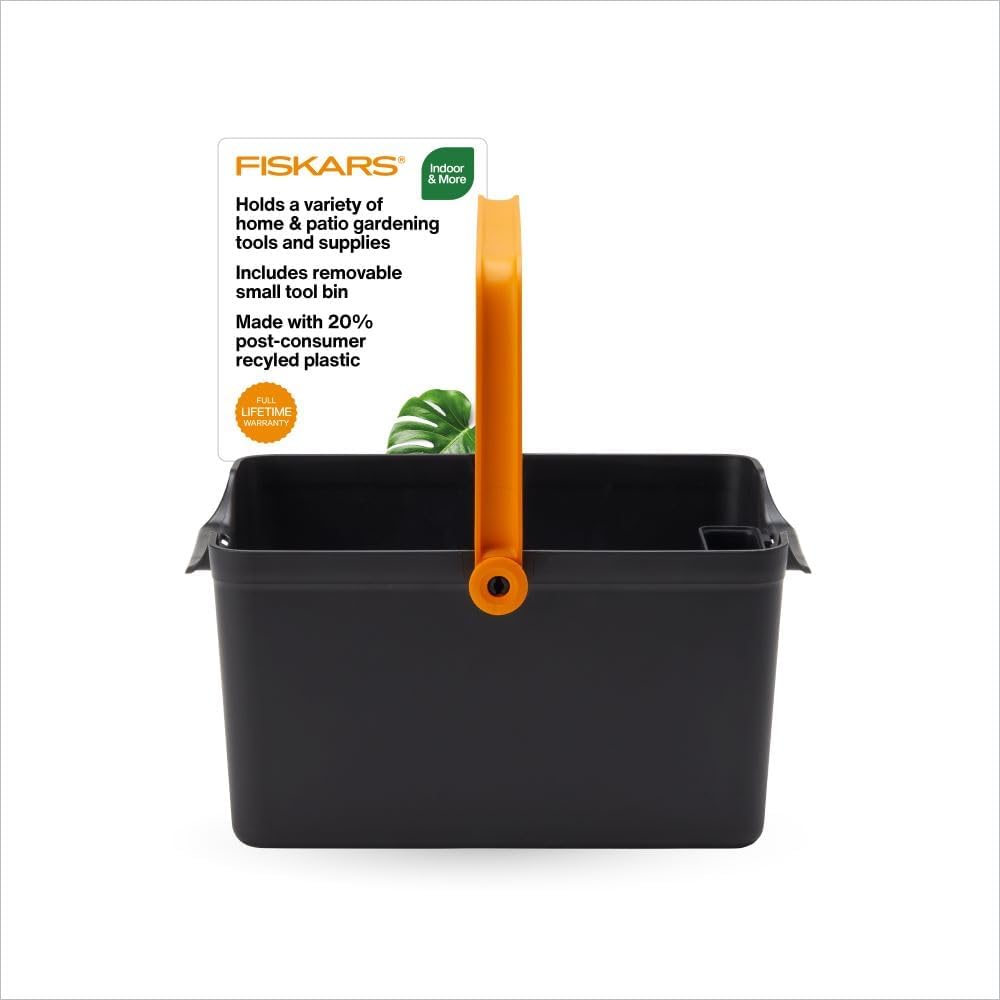Create a Spectacular Shade Garden With Containers
You don’t need a lot of sun or even access to the soil to have a lovely landscape

Just when I get a gardening routine down pat, new challenges arise to test my knowledge or shatter my perceptions. Such was the case when I moved from my previous garden—which had an open exposure bathed in sun from morning to sundown—to a garden overshadowed by tall trees.
My new gardening venue is a bluestone terrace surrounded by a mixed woods of tulip tree, American ash, and white oak. The 100-foot-high canopy is especially heavy on the south side, casting shade for most of the day. I wanted to make this terrace a home for a collection of potted plants, but I was skeptical about what would do well there.

I’ve since realized that container gardening in the shade offers numerous benefits. Shaded pots don’t dry out as fast as ones baking in full sun, so watering is less of a chore. Of course, with plants growing in pots there’s no competition from tree roots, which is often the case with shade gardening. Best of all, I’ve discovered wonderful new plants and different ways to combine them.
Assess your site’s sun-and-shade patterns
Before buying plants, observe how much light and shade your site enjoys. While full sun means direct sun shines all day during the summer, there are several degrees of shade. In light shade, plants get four to six hours of direct sun or a slight pattern of shade all day. In partial shade, plants get two to four hours of sunlight or a pattern of dappled shade. In full shade, there’s only reflected, indirect light, while in dense shade there’s little indirect light.
Given that the angle of the sun changes during the season, the sun-and-shade patterns on my terrace are highly erratic. I can count on direct sunlight hitting the terrace only when the arching sun shines through the voids between tree canopies; otherwise, dappled light falls as the sun pierces the canopy. At the height of summer, the most sun any part of the terrace received was three hours. Thus, I was dealing with partial- to full-shade conditions.
Look for zesty forms of old standards
Being a fan of the new and different when it comes to plants, I was tempted to disregard the standard repertoire of shade-loving plants—begonias, impatiens, and coleus. But then I remembered that it’s how plants are used that makes them special. With a little hunting, I found striking cultivars of each. They provided eye-catching color and set the mood for my container vignettes.
One of my favorite discoveries was Begonia ‘Dragon Wings Hybrid’. This fibrous-rooted begonia has shiny, medium-green leaves and dangling red blossoms borne in clusters at the ends of arching stems. While it can be likened to a wax-leaved begonia, its lax habit and stature set it apart. I grew it in black-painted, cast-iron urns, combining it with white-variegated flax lily (Dianella tasmanica ‘Variegata’) in the urn’s center and variegated ground ivy (Glechoma hederacea ‘Variegata’) spilling down the sides in long chains of foliage.

I found two exceptional selections of double impatiens. ‘Pink Ice’ boasts variegated foliage and salmon-pink flowers. The cultivar ‘Red’ of the Rose Parade Series produces deep-red blooms in great profusion. As a solo planting, it accented a pairing of pots with a red-and-pink color scheme. These larger pots featured a pink-and-green selection of coleus, Lobelia ‘Queen Victoria’, Fuchsia ‘Gartenmeister Bonstedt’, Lamium maculatum ‘White Nancy’, variegated ground ivy, Hosta ‘Patriot’, and variegated lilyturf (Ophiopogon jaburan ‘Vittatus’).
Nearly every grouping of pots showcased coleus. With the explosion of new coleus available, there’s a cultivar to fit almost any color scheme. Their leaves vary from a single, solid hue to a complex mix of colors. One such planting featured a large pot of coleus (a sport of ‘The Line’), which I carry over from year to year as cuttings. It anchored a grouping of yellow-leaved plants accented by ones with orange, apricot, and salmon flowers.
Don’t be afraid to experiment
Although in general I looked for plants known to thrive in shade, there were a few sun-lovers I just didn’t want to give up. Some, such as angel’s trumpets (Brugmansia ‘Jamaican Yellow’), fared well. Plants that require prolonged intense sun, such as Petunia hybrids, lavenders (Lavendula spp.), and curry plant (Helichrysum italicum), did not. And herein lies a valuable lesson: Each shady site is different, so experimentation is the only way to know for sure what will do well in a given situation.

To my surprise, Canna ‘Durban’ grew well and even bloomed. Of course, even if this canna had never bloomed, its intricately veined, green-and-yellow leaves alone would have warranted its cultivation. Yellow-variegated American aloe (Agave americana) held its own, even growing slightly through the season. Pinwheel (Aeonium haworthii) and mescal (Agave parryi), both succulents, grew well and added their blue note of foliage interest. These made a stunning picture when combined with a selection of hot-water plants (Achimenes cvs.).
Foliage can add structure and color
More than anything else, foliage gives body to container groupings. It provides the backbone and adds color to reinforce the floral display. I think variegated plants are invaluable in shade gardening; they brighten up shadowy areas, and their leaf colors and patterns relieve the monotony of green.
One of my groupings relied solely on foliage for impact. At its center was a Begonia ‘Exotica’, a variegated begonia that lives up to its name. Its leaves are olive-green with deep-pink blotches and a metallic sheen. The thin, deep-maroon leaves of blood leaf (Iresine lindenii) offered textural contrast, and Caladium bicolor ‘Rosalie’—with deep-red-centered leaves edged in green—echoed the blood leaf. A lone red impatiens added a bit of floral color while reinforcing the red theme. A young specimen of a lacecap hydrangea (Hydrangea macrophylla ‘Mariesii’), with its white-edged leaves, added contrast to this somewhat monochromatic scheme.
I’m glad I’ve discovered the rewards of gardening with potted plants in the shade. Now I’m excited about the countless possibilities for what I might grow on my terrace next season.
Garden designer Gary R. Keim gardens near Philadelphia.
Photos: Lee Anne White
Fine Gardening Recommended Products

Berry & Bird Rabbiting Spade, Trenching Shovel
Fine Gardening receives a commission for items purchased through links on this site, including Amazon Associates and other affiliate advertising programs.

Chapin International 10509 Upside-Down Trigger Sprayer
Fine Gardening receives a commission for items purchased through links on this site, including Amazon Associates and other affiliate advertising programs.

Fiskars Garden Tool Caddy with Removable Small Tool Storage for Indoor and Outdoor Gardening Use, Made with Recycled Plastic
Fine Gardening receives a commission for items purchased through links on this site, including Amazon Associates and other affiliate advertising programs.






Comments
Log in or create an account to post a comment.
Sign up Log in